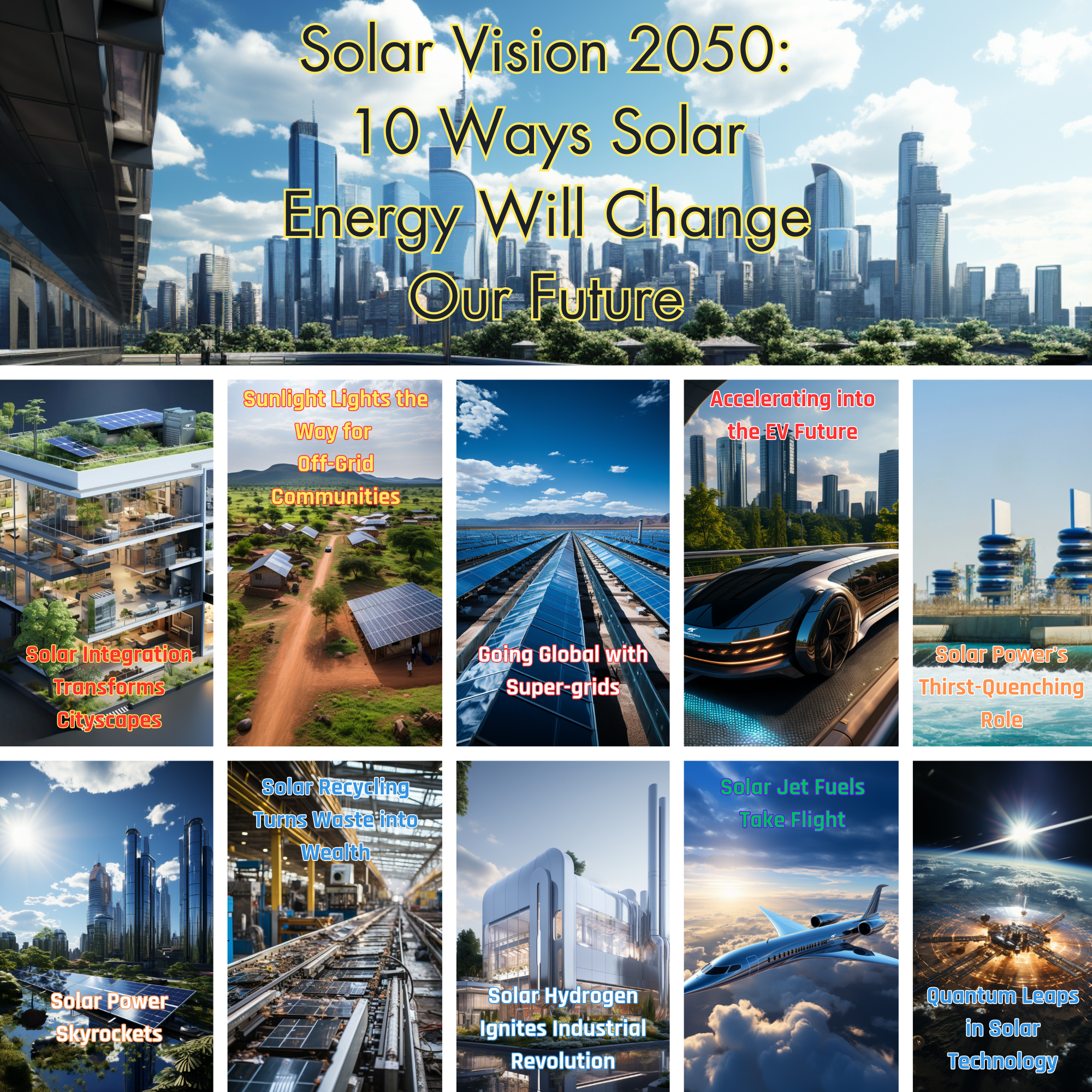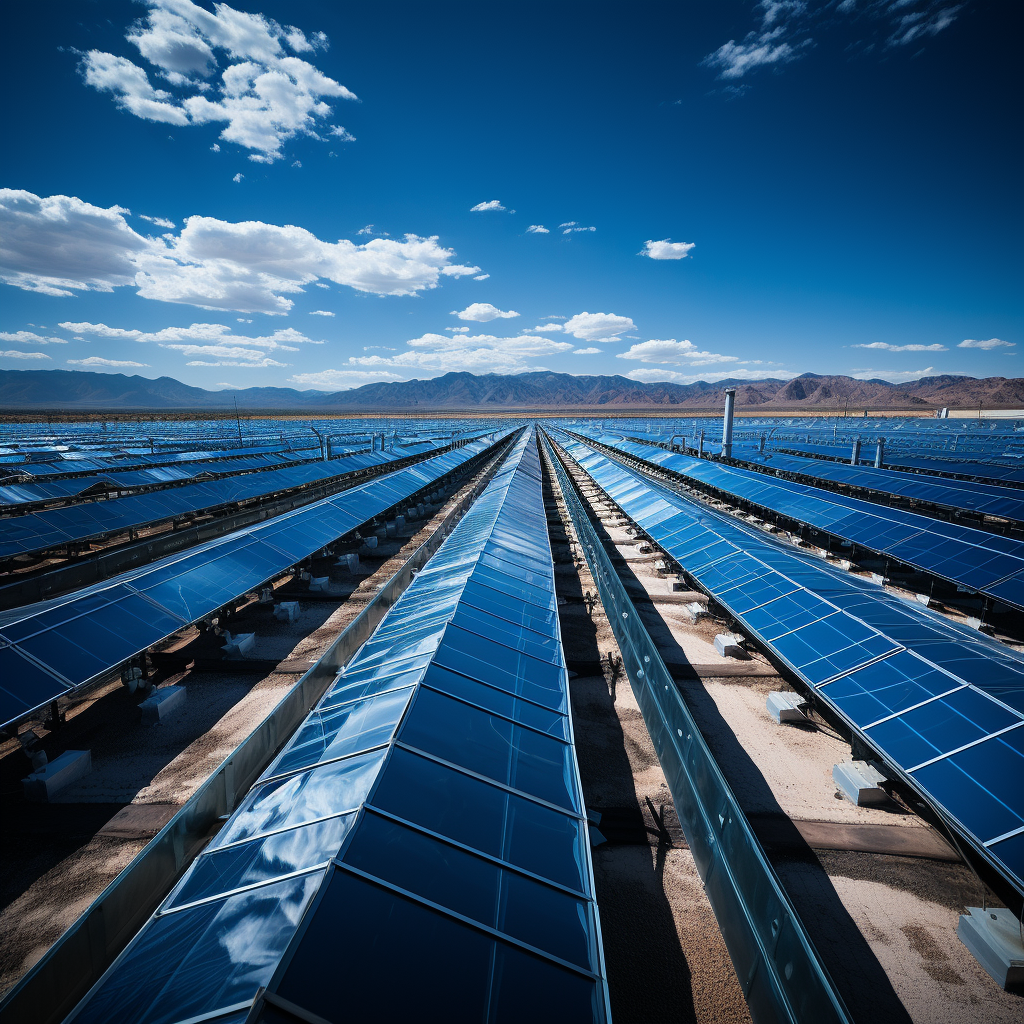
Solar power is poised to take the main stage in the coming decades, fundamentally changing how we produce and use energy in ways both big and small. By 2050, the endless potential of the sun will have reshaped energy systems around the world.
These shifts go beyond sustainability - they’re about creating a more independent and innovative future. Solar energy will flip the script on how we power our lives. The solar revolution isn't some far-off dream; it's already underway.
As we look ahead to the middle of this century, there are ten key ways the sun’s rays will alter our world:

Solar power, currently a small contributor to the global energy portfolio at just 2%, is poised for a dramatic ascension. By the middle of the century, experts predict it could fuel up to 45% of our electricity needs, outpacing traditional energy sources such as coal, oil, and gas. The International Energy Agency even foresees a future where solar reigns supreme, topping the chart of electricity sources by 2050. Yet, this surge towards the sun isn't without its fair share of clouds.
Indeed, the path to solar primacy is riddled with challenges. The sun, while an abundant resource, is an intermittent one. It doesn't shine all day, and the whims of weather can throw a wrench into energy collection efforts. Solar power's effectiveness is also a slave to geography; in regions where sunlight is scarce, energy production naturally dips. Even the logistical aspects, like manufacturing solar panels on a grand scale and revamping the grid to accommodate this renewable power source, present their own set of complex and costly problems. Yet, we're not without solutions. Advancements in energy storage technologies, such as improved batteries, can help combat these issues, and ongoing research may eventually erase the geographical limitations.
In the grand chessboard of geopolitics, the solar surge can rewrite the rules of the game. As nations wean off fossil fuels, those known for their vast reserves of oil, coal, or gas may find their influence waning. Meanwhile, regions bathed in sunshine could step into the limelight as the new power players. This shift towards solar may foster energy independence and ease global tensions over resources, but it could also stir up fresh challenges for those nations grappling with the switch to renewables. All things considered, the race for solar power is set to redraw the world's energy map in ways we might not yet fully comprehend. Therefore, it is essential to maintain adaptive and forward-thinking policies to navigate this new energy landscape.

The wheels of the automobile industry are turning electric. By 2030, experts predict electric vehicles (EVs) will represent a whopping 45% of new car sales globally. Add solar charging stations to this mix, and the sun could eclipse over 10 million barrels of daily oil demand. And it's not just the environment that stands to gain. With battery prices on a downward trajectory, the total cost of EV ownership is set to rival that of gasoline cars by 2025. But the road to an electric future isn't without its bumps.
One of the significant roadblocks to EV adoption has been the scarcity of charging stations and the daunting charging times. But we're quickly overcoming these hurdles. Governments and businesses are joining forces to dot the map with charging stations both locally and globally. And the charging technology itself is getting a speed boost. Continuous research and development in high-speed charging technologies are drastically slashing the time it takes to juice up an EV.
Looking ahead, the promise of EVs shines brighter than ever, thanks in large part to the leaps and bounds in battery technology. Today's EVs, armed with a few hundred miles of range per charge, meet most daily needs but can still trigger "range anxiety." But the EVs of tomorrow, powered by advanced batteries like solid-state and high-capacity lithium-ion cells, are set to put these fears to rest. Intense research and development in these areas hint at a future where an EV could drive over 1,000 miles on a single charge. While the transition to EVs is not without its share of challenges, the relentless march of technology promises a more practical and convenient electric future. We're not just steering towards this future—we're charging full speed ahead.

Solar energy is poised for a transformative leap with the advent of technologies like perovskite solar cells and quantum dots. Perovskites, crystalline materials adept at absorbing sunlight, demonstrate over 25% solar conversion efficiencies in labs, competing with traditional silicon cells. Their potential for simple, low-temperature manufacturing paves the way for cost-effective, highly efficient solar panels.
Solar thermophotovoltaics represent an innovative approach to solar energy, absorbing sunlight, converting it into heat, then transforming this heat into light, which is finally turned into electricity. This multi-step process allows for individual optimization of each conversion, potentially offering efficiencies beyond 50%.
Quantum dots, tiny semiconductor particles, can be fine-tuned to absorb light across the solar spectrum efficiently. When integrated into paints or coatings, they could transform a myriad of surfaces into solar collectors.
Proposals for space-based solar power envision massive orbital arrays beaming energy to Earth. While this method would circumvent obstructions like night, clouds, or atmospheric absorption, it faces substantial financial and engineering challenges.
While existing silicon panels are likely to see ongoing enhancements, the emergence of advanced solar technologies could unlock unprecedented levels of clean, renewable energy in the future.

Over 2 billion people grapple with water scarcity, and solar desalination offers a sustainable solution. Saudi Arabia, for example, has set a goal to produce 2.2 million m3/day of desalinated water from solar by 2030.
Technological advancements are paving the way for solar desalination to significantly shape the development of future cities. By 2050, this technology is expected to be vital for water security, influencing urban planning and sustainability.
Dubai and Neom, Saudi Arabia, are leading the way, incorporating solar desalination into their infrastructure planning. Projects include giant solar power plants with solar-powered reverse osmosis desalination systems, making solar desalination a crucial component of sustainable urban design.
Algeria, home to Africa's largest desalination plant, harnesses solar power to combat water scarcity. By 2050, it's projected that around 800 million Africans could potentially benefit from desalinated water, demonstrating the scalability of this eco-friendly solution.
Advancements in renewable energy storage, such as solar thermal, and Reverse Osmosis (RO) techniques, are set to transform desalination. RO is a process where water is pushed under pressure through a semipermeable membrane, creating fresh water from salty or contaminated sources.
As urbanization accelerates, sustainable water provision via solar desalination will be an integral part of city planning and development, potentially transforming cities into sustainable hubs by 2050.

Solar renewable jet fuel derived from water and CO2 could supply 100% of aviation fuel demand by 2050. Test flights have already validated that solar jet fuels can decrease lifecycle emissions by over 80% compared to conventional jet fuel.
The production of solar renewable jet fuel involves using sunlight, water and carbon dioxide (CO2) through an innovative Solar-to-Fuel technology or Direct Air Capture (DAC) process for CO2. In this process, concentrated sunlight converts carbon dioxide and water into synthetic jet fuel in a reactor often designed as a tower. The tower takes in carbon dioxide extracted directly from the ambient air, water, and sunlight as its only inputs to produce the jet fuel.
According to the International Energy Agency, by 2050, Direct Air Capture (DAC) could be substantially scaled up to achieve net-zero emissions. Currently, DAC technology relies heavily on energy-driven processes like solar thermal and biomass-based fuels. But as we approach 2050, innovations and advances in these areas will likely enable significant contributions towards scaling up DAC.

Today nearly 800 million people lack electricity. Off-grid solar systems can provide affordable, reliable, and clean energy access. With financing support, decentralized solar could reach 1 billion people currently without power by 2030.
The future of off-grid solar is intertwined with microgrid development, especially in areas lacking infrastructure. The DOE's Solar Futures Study indicates solar capacity must reach 1,600 GWac by 2050. Such systems could enable microgrids to power critical loads during grid outages, demonstrating decentralization from traditional grids, often compromised in remote areas.
Renewable energy, led by solar, will supply microgrids and off-grid systems with limited grid dependence. Such systems foster localized generation and can rapidly electrify regions without grid access. They provide affordable, efficient, clean energy to support community needs in remote locations.
Off-grid solar could significantly impact Africa, where reliable electricity access is minimal. Despite solar projected to represent just 6% of Africa's generation by 2050, investments in off-grid solar microgrids could substantially increase this figure, creating new opportunities for energy access and growth. With supportive policies and financing, off-grid solar and microgrids could transform Africa's energy landscape, moving away from unreliable sources towards renewables, bringing positive change in energy and socioeconomics.

Buildings that are completely energy self-sufficient, equipped with integrated solar PV and battery storage, are projected to make up more than half of all new constructions by the middle of this century. These green structures, creating as much renewable power as they use from their very own solar systems, will be pioneers in the journey away from grid electricity powered by fossil fuels. As they multiply, they'll reshape our cityscapes and communities, turning them into living exhibits of sustainable design.
These green structures, generating as much renewable energy as they consume with their on-site solar systems, are set to play a key role in the shift away from fossil fuel-powered grid electricity. Their increasing presence will transform cityscapes and neighborhoods, demonstrating sustainable design in action.

Solar electricity is at the heart of green hydrogen production—a clean, sustainable process known as solar-driven electrolysis. Picture this: solar panels soak up sunlight, generating electricity which then powers an electrolyzer. This clever device breaks water into hydrogen and oxygen, and voilà, you've got green hydrogen.
Green hydrogen isn't just a buzzword; it's a game-changer for heavy industries like steel, chemical, and cement production. It can wipe out on-site emissions when used as a fuel source. What's more, it's adaptable, capable of being converted into electricity or synthetic gas, which opens up a wide range of applications across different sectors. Imagine if these industries fully embraced green hydrogen from solar—doing so could be a significant step towards zero-emissions objectives.
Fast forward to 2050, and we could see up to 30 million tons of solar hydrogen produced annually. That's a hefty amount, enough to give many factories a break from relying on fossil fuels. Picture those old, smoky steel, chemical, and cement plants switching to green hydrogen and cutting down their smokestack emissions. It's as if a gigantic broom is sweeping away the toxic waste, helping industrial production to clean up its act and move towards more sustainable practices.

With solar panel waste projected to total up to 78 million tonnes globally by 2050, recycling panels at end-of-life is crucial. Rather than sending old solar panels to landfills, repurposing or recycling them could provide both environmental and economic benefits.
Emerging technologies can recover valuable materials like glass, silicon, and silver from old panels for use in manufacturing new ones. This reduces the need for new resource extraction. The International Renewable Energy Agency (IRENA) estimates that solar panel recycling could unlock up to $15 billion in global salvage value from solar waste by 2050.
More specifically for the U.S. solar industry, recycling could generate $60 million in the domestic recovered materials market as early as 2030. This number could rise to $2 billion in the U.S. by 2050. Beyond potential revenues, PV recycling also promises benefits like supply chain resilience, lower production costs, sustainability, new revenue streams, tax incentives, and green jobs creation.

As solar power expands dramatically, innovating the electricity grid itself may enable widespread renewable energy sharing globally. One proposed solution is establishing massive intercontinental high voltage direct current (HVDC) super-grids. These could facilitate transferring solar electricity across regions.
The ambitious Asia Super Grid proposal would distribute solar power from Australia to Asian nations via underwater cables. By tapping Australia's tremendous solar resources, the Asia Super Grid could provide clean energy to partners thousands of miles away.
While technically feasible, intercontinental HVDC grids are a complex geo-economic challenge requiring international cooperation and investment. If achieved, super-grids would allow solar-rich countries to export renewable electricity globally. Unlocking solar power sharing could accelerate decarbonization and interconnect the renewable energy future.
Era of Unlimited Possibilities Emerges
The solar revolution once seemed a distant dream, but it is now an unfolding reality that is transforming how we power our world. Solar energy has gone from concept to game-changer, impacting every industry and lighting the path to sustainability.
The endless potential of the sun is fundamentally changing our energy systems and approach. Solar power is no longer just an idea for the future—it is powering our present, each new solar installation further unleashing its possibilities.
By 2050, the solar transformation happening today will offer hope to coming generations through cleaner air, new jobs, and energy independence. What was once a vision for tomorrow is now a growing force for good, enabling cleaner lives.
The sunlight that beams down each day brings more than light and warmth—it brings the promise of a brighter future. One powered not by fossil fuels, but by the unlimited potential of the sun. Solar energy is flipping the script on how we produce and consume power. And in doing so, it’s lighting the way to a more sustainable world.
Zero $ out
of pocket
Max credits
incentives
Honest &
transparent
14 years of
100% solar
1. Estimate savings on your energy use 2. Leverage the best state incentives
Try our Layout Design Tool!
MAIN OFFICE
216 River Avenue
Lakewood, NJ 08701
732-987-3939
NEW JERSEY
2 University Plaza #100-1
Hackensack, NJ 07601
201-624-9696
NEW YORK
56 South Main St Suite #2
Spring Valley, NY 10977
845-553-7100
NYC
1310 Coney Island Ave
Brooklyn, NY 11230
718-502-3200
MIAMI FLORIDA
66 West Flagler Street
Suite 900-3747
Miami, FL 33130
786-732-3306